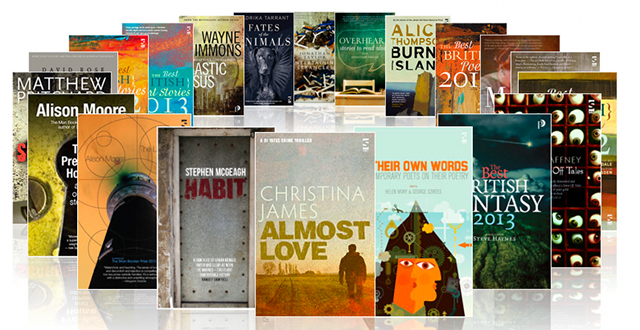Leading UK independent literary publishing house—and e-book producer—Salt Publishing has decided, “after thirteen years and over 400 poetry collections, many by debut authors,” to stop publishing poetry by individual poets and concentrate on anthologies in the future. “Salt concentrates its future poetry efforts on the best of British” was how the headline on the Salt Publishing blog put it.
The Guardian coverage quoted Salt director Chris Hamilton-Emery as saying: “”We’ve seen our sales [of single-author collections] decline by over a quarter in the past year, and our sales have halved in the past five years … It’s simply not viable to continue doing them unfunded.” He attributed the British poetry market’s problems to a sharp drop in foot traffic at bookstores, and a proliferation of small presses.

“Is British poetry healthy right now?” blogged poet Clare Pollard. “Squeezed by the recession and the big buyers, the half-dozen major presses are only accepting one or two or no debuts each year. Poets can end up spending years just waiting for rejections from them.”
And of Salt’s demise, she said, “The news that their poetry publishing will now be slashed to a single annual anthology is terrible for British poets. I mean, their list is bursting with talent: a whole, brilliant generation.” Interestingly, Pollard’s analysis of the publishing options available to new poets made no mention of self-publishing, or e-books.
“I thought I’d stick to addressing the traditional publishing model as that’s still what most poets aspire to,” Clare Pollard told me in an email. “A self published poetry book won’t get reviewed and won’t be eligible for any prizes. Poetry e-books also seem—from what I have heard and read within the industry—to sell very few copies indeed, as poetry fans still seemed attached to physical books (though correct me if I’m wrong). If the problem is poetry not finding a readership, telling young poets to self publish would currently mean they’d likely to be sending it into a void … Still, that’s not to say things won’t change, of course.”
The UK Kindle Store does currently list a number of Salt Publishing poetry titles in Kindle format in its Salt Modern Poets series, including The Corner of Arundel Lane and Charles Street by Tony Williams and Unexpected Weather by Abi Curtis, almost all of which carry four-and-a-half to five star customer reviews. “This is a beautiful book,” runs one typical review of the latter. “Curtis’s poetry is by turns wonderfully perceptive, delicate, tough, quirky, funny, poignant and haunting.” And I have to agree that these are beautifully produced and well formatted books that apparently have made the transition to Kindle gracefully. All retail at around £7.20 ($10.90).
“Over 80% of our revenue is made from our fiction list, the rest is divided between our poetry publishing and our non-fiction titles,” says the Salt website—and obviously we now know how the division of that less than 20 percent remainder goes. “Just over a quarter of our total income is now derived from our anthology publishing.”
“There’s never been a better time for poets to write,” says Chris Hamilton-Emery, director at Salt. “There are huge opportunities for poets to publish in new ways—and there are scores of new presses emerging, too. It’s an exciting time.” Obviously the excitement has mostly moved on from Salt. Hamilton-Emery was unavailable for further comment.
Not everyone is having such a difficult time with the genre, though. “My publishing company is on year three of its poetry competition,” answered one enterprising Texan author and small publisher on the Kindle Boards. “It’s a loss for the company, but not too bad of one, and I like the attention it gets and literary angle it gives my press. I’ve worked with some very talented poets now and we always get someone fabulous to judge it.”
Previously I’ve written about the problems of formatting poetry for e-books, and the need for some standards and solutions to address this. Now it seems there is more need than ever.

































Quote: “Previously I’ve written about the problems of formatting poetry for e-books, and the need for some standards and solutions to address this. Now it seems there is more need than ever.”
I fully agree. All the calls about embedding audio and video into ebooks miss something more important: giving an author/publisher the same ability to lay out the text in predictable ways that’s been around in printing since Gutenberg. That’s particularly important with poetry, where font choices, text indention, and spacing between lines play a major role in creating an appealing book.
And to get the major ebook retailers to listener, poetry writers may need to take a firm stand, supporting platforms that make attractive poetry possible and ignoring those that don’t. Right now I suspect that means publishing with Apple but not Amazon.
I don’t write poetry. But I recently decided the audience for one of my books would like to see pictures added to Hospital Gowns and Other Embarrassments: A Teen Girls Guide to Hospitals. Locating just the right pictures took many hours, but from BigStockPhoto, they proved surprisingly inexpensive. The resulting combination is, I think, most impressive.
The hitch came when I published. InDesign’s ePub 3.0 export produced a marvelous version for the iBookstore and iPads. The pictures fill the width of the screen and the text looks great.
Amazon’s own Kindle export plug-in for InDesign proved a major disappointment. The pictures actually look better in black-and-white on my ePaper Kindle 3 than they do in the Kindle app on my iPad. On the latter those full-sized pictures were reduced to little more than thumbnails. They look awful, so bad the book would actually be more attractive without them.
Smashwords was even worse, confirming my impression that it’s still not useful for anything but basic text novels. I was happy to see that their ePub import no longer fails on an ePub 2.0 generated by InDesign. That’s good, particularly when the files they’re sending B&N and others are ePubs. But as best as I can tell by downloading my own book, Smashwords simply discarded all those pictures without even generating an error message. Not good.
For now, I’d suggest that the writers of poetry focus on publishing through Apple’s iBookstore. Rather than deal with all the hassles of formatting for multiple platforms, concentrate on making their book look really good on one.
Not only will that let them layout the book exactly as they like, including embedding the font of their choice, they don’t need to use costly InDesign or deal with the miseries of Word. They can use Apple’s free IBooks Author app. The latter will even let them control precisely what appears on each page, something that’s absolutely necessary in making a book of poetry look good. You don’t want that last line of the poem to break onto a new page.
Almost every problem has an upside. The new digital technologies are creating problems, but they also offer opportunities. In the past, poets might have had to fuss with publishers to get graphics included and they had no chance of getting color pictures included, four-color printing being very costly in small print runs. But now all that can be included.
Perhaps poets need to partner with artists and photographers to create books that blend multiple art forms. A poem about hectic city life, for instance, might be combined with a well-chosen photo of a busy city sidewalk. In our more visual age, the combination might reach people who’d never read a book of poetry that’s just words.
Remember, every problem is also an opportunity.